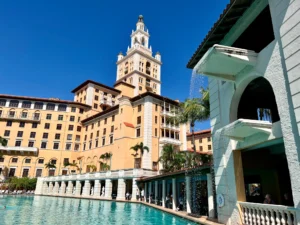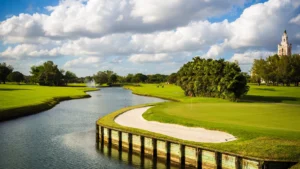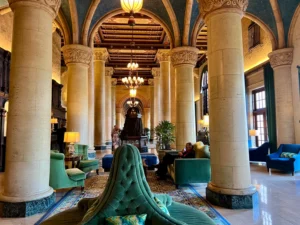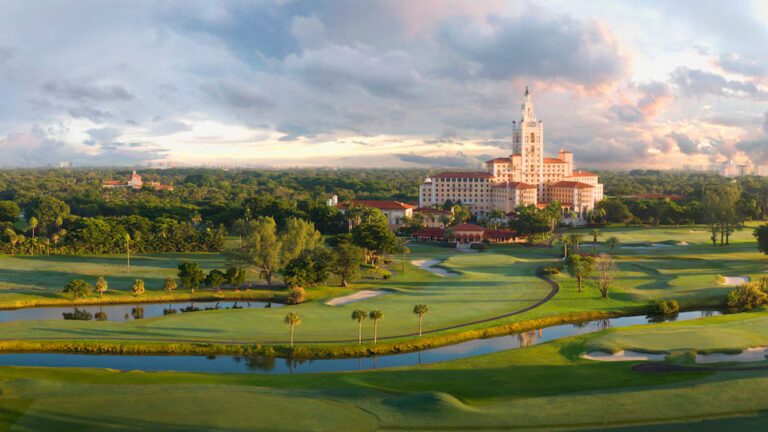There is nothing subtle about the venerable Biltmore Resort in tony Coral Gables, a well-heeled and dynamic city in the Miami metropolitan area some six miles south of Miami International Airport.
The property, which opened in 1926, is lorded over by the iconic hotel tower that was modeled after Giralda, the medieval tower of the cathedral of Seville, Spain. The hotel itself is a National Historic Landmark, having served as the playground for the rich and famous in its early years, as a 1,200-bed hospital during World War II, and as a veterans’ hospital and the University of Miami’s School of Medicine until 1968.
After more than a decade of abandonment, The Biltmore reopened as a luxury hotel and resort on New Year’s Eve of 1987. In the nearly 40 years since it has undergone continual upgrades and modernization that have only enhanced its classic appeal, making it stand alone in the area as an example of the Mediterranean Revival style.
The centerpiece of the hotel proper is its gleaming swimming pool, which — at more than 600,000 gallons — was the largest in the world when it was first built and is surrounded with Renaissance-style sculptures.

The main attraction for our purposes was the resort’s Donald Ross-designed golf course, which opened in 1925 and was once the host of The Miami-Biltmore Open, which carried one of the richest purses in professional golf during its stint.
We were lucky enough to stay and play at The Biltmore during a recent trip to South Florida and found the entire property magical and is staff attentive, friendly and highly proficient.
Ross’ genius on ready display at The Biltmore
The course played presently at The Biltmore Golf Club is nearly identical to the one Ross fashioned a century ago save for the sequence of holes. Brought back to life when the resort reopened, the course was restored in 2007 by Ross aficionado Brian Silva, who changed the routing but retained all the original holes as well as 84 of the 85 bunkers Ross had designed.

Silva returned to the course in 2018-19 to add length and playability and built USGA specified greens that have been re-grassed with Tif-Eagle Bermuda and restored to their original size. Now the back-tee yardage tips out at 7,112 yards at a par of 71, making The Biltmore Golf Club one of the great Golden Age-designed courses that connects the modern game with its past.
“We sought to bring back Ross’ original characteristics of play, which has a great deal of movement,” Silva said. “The result is a spectacular course that will maintain the playing interests of an accomplished golfer while also being manageable for all levels of players to enjoy.”
Ross did not have an excess of sand to form mounding on the holes when he designed The Biltmore Golf Club and was forced to make clever use of canals and sharp property boundaries and devilish greens complexes to make his statement and provide challenges throughout. While the course has very little rise and fall, there are also plenty of subtle slopes and valleys that force players into hitting shots with total conviction and skill.
The strength of the championship golf course is its superb collection of par 4s. They range from drive-and-pitch gems to dangerous holes like the 490-yard 17th, which calls for a solid drive followed by an unerring approach over water to a bulk-headed green.

The round ends with a 543-yard par 5 that bends to the left and ends at the largest putting surface on the track; the mounding on the final green (which sits in the shadow of the hotel’s massive tower) makes accuracy on the approach paramount.
The fairway bunkers pull the player through this golf course, as Ross designed the corridors to subtly twist and turn around the sand, even on the straightaway holes. The real tests at The Biltmore Golf Club are interspersed with birdie opportunities, with the water creating a real sense of drama on numerous offerings.
There are very few trees on the course but lots of doglegs with water in play on six holes. Almost every hole at The Biltmore can be seen from the patio of its extensive clubhouse, which is a throwback to classic golf architecture.
The Biltmore Golf Club is one of those very few resort/public courses that combine the best of design, conditioning and history and is a must-play for those that love Ross’ work.
The hotel is something special, too
Hand painted frescos on barrel-vaulted ceilings, travertine floors, fine marble columns, carved mahogany furnishings and lavish gardens create picturesque locations throughout The Biltmore Resort.

Each of the property’s 271 guest rooms (173 of them suites) feature a color palette of plums, silver sage and regal gold. Open-air balconies provide breathtaking views. There are four restaurant on site, as well a massive spa, a salon, a fitness center and tennis courts.
It’s hard not to be struck by the sheer scale and opulence of the place. Everything is stylishly appointed and classic, and it’s clear that no expense has been spared when it comes to those little touches that transform even great hotels into five-star ones. The luxury feel pervades all corners of this grand complex, from the pool, rooms and spa to the excellent golf course.
The Biltmore Resort is a throwback to the South Florida of the Roaring 20s while also providing all the modern amenities today’s travelers crave and expect — and that’s a good thing.


